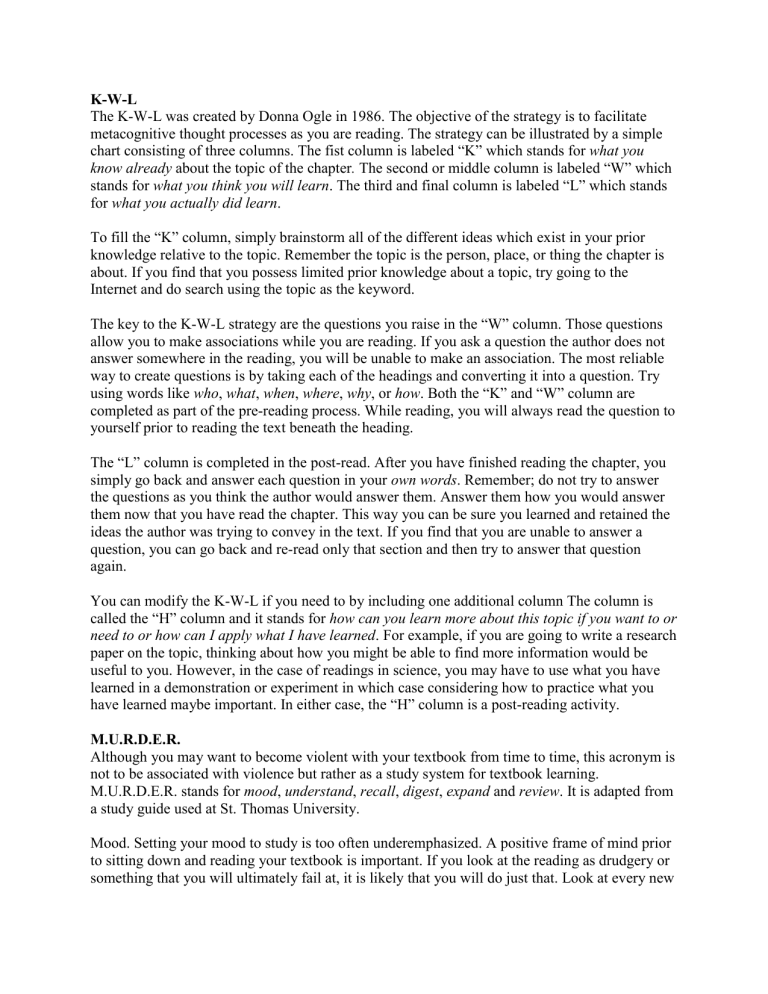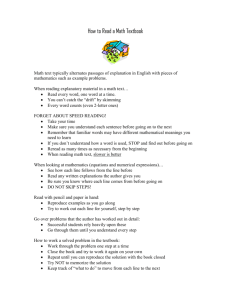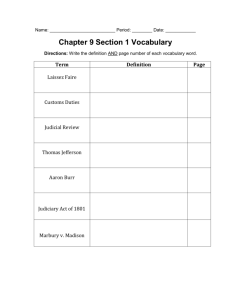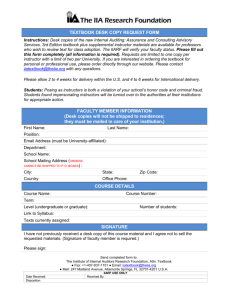Textbook Handout 2

K-W-L
The K-W-L was created by Donna Ogle in 1986. The objective of the strategy is to facilitate metacognitive thought processes as you are reading. The strategy can be illustrated by a simple chart consisting of three columns. The fist column is labeled “K” which stands for what you know already about the topic of the chapter .
The second or middle column is labeled “W” which stands for what you think you will learn . The third and final column is labeled “L” which stands for what you actually did learn .
To fill the “K” column, simply brainstorm all of the different ideas which exist in your prior knowledge relative to the topic. Remember the topic is the person, place, or thing the chapter is about. If you find that you possess limited prior knowledge about a topic, try going to the
Internet and do search using the topic as the keyword.
The key to the K-W-L strategy are the questions you raise in the “W” column. Those questions allow you to make associations while you are reading. If you ask a question the author does not answer somewhere in the reading, you will be unable to make an association. The most reliable way to create questions is by taking each of the headings and converting it into a question. Try using words like who , what , when , where , why , or how
. Both the “K” and “W” column are completed as part of the pre-reading process. While reading, you will always read the question to yourself prior to reading the text beneath the heading.
The “L” column is completed in the post-read. After you have finished reading the chapter, you simply go back and answer each question in your own words . Remember; do not try to answer the questions as you think the author would answer them. Answer them how you would answer them now that you have read the chapter. This way you can be sure you learned and retained the ideas the author was trying to convey in the text. If you find that you are unable to answer a question, you can go back and re-read only that section and then try to answer that question again.
You can modify the K-W-L if you need to by including one additional column The column is called the “H” column and it stands for how can you learn more about this topic if you want to or need to or how can I apply what I have learned . For example, if you are going to write a research paper on the topic, thinking about how you might be able to find more information would be useful to you. However, in the case of readings in science, you may have to use what you have learned in a demonstration or experiment in which case considering how to practice what you have learned maybe important. In either case, the “H” column is a post-reading activity.
M.U.R.D.E.R.
Although you may want to become violent with your textbook from time to time, this acronym is not to be associated with violence but rather as a study system for textbook learning.
M.U.R.D.E.R. stands for mood , understand , recall , digest , expand and review . It is adapted from a study guide used at St. Thomas University.
Mood. Setting your mood to study is too often underemphasized. A positive frame of mind prior to sitting down and reading your textbook is important. If you look at the reading as drudgery or something that you will ultimately fail at, it is likely that you will do just that. Look at every new
reading assignment as an opportunity to become better in some way or as meeting another challenge in the pursuit of your college degree. If something is bothering you that may prevent you from establishing a positive attitude, perhaps you should put off the reading until you have reconciled what ever is troubling you. Decide what environment creates the least amount of anxiety for you and then read there. It doesn’t have to be quiet, music does not have to be a distraction, It can sometime enhance the environment. Be physically comfortable, but reading in bed before you normally go to sleep may not be the best time to read a textbook.
Understand. Use a highlighter to identify any information in the reading that you find difficult to understand. You can either come back and reread that section later or ask your instructor to help explain the idea in a different way.
Recall. After you have completed the reading, write a summary of the chapter being sure to use your own words. Again, it is important to summarize your thoughts as they relate to the reading and not simply those of the author. Be sure to include in your summary, the topic, the points the author made about the topic and the major support for those points.
Digest. After you have written your summary, go back and reread any print you highlighted.
Often after you have read the entire chapter something that seemed difficult to understand early in the chapter is more easily understood now that you have finished the chapter. If after rereading, the information remains unclear, perhaps you can e-mail your instructor and ask for clarification. In addition you may also be able to locate the e-links to web sites in the chapter and visit those sites for more information.
Expand. This is the key step in this strategy. Here you formulate three kinds of questions:
1.
If I could speak to the author, what questions would I ask or what criticism would I offer?
2.
How could I apply this material to what I am interested in?
3.
How could I make this information interesting and understandable to other students?
If you are able to develop complete answers to these questions or similar questions, you have gone beyond the print and have begun to personalize the new information you have now acquired. Once it becomes yours , now it is part of your prior knowledge that can be triggered again and again to help you prepare to read and learn more from additional chapters in this textbook or others.
Review. Think about what strategies helped you understand and/or retain information in the past and apply these to your current studies
What do you
KNOW about this already?
What do you
WANT to know about this?
What did you
LEARN about this?
M.U.R.D.E.R.
Although you may want to become violent with your textbook from time to time, this acronym is not to be associated with violence but rather as a study system for textbook learning.
M.U.R.D.E.R. stands for mood , understand , recall , digest , expand and review . It is adapted from a study guide used at St. Thomas University.
Mood. Setting your mood to study is too often underemphasized. A positive frame of mind prior to sitting down and reading your textbook is important. If you look at the reading as drudgery or something that you will ultimately fail at, it is likely that you will do just that. Look at every new reading assignment as an opportunity to become better in some way or as meeting another challenge in the pursuit of your college degree. If something is bothering you that may prevent you from establishing a positive attitude, perhaps you should put off the reading until you have reconciled what ever is troubling you. Decide what environment creates the least amount of anxiety for you and then read there. It doesn’t have to be quiet, music does not have to be a distraction, It can sometime enhance the environment. Be physically comfortable, but reading in bed before you normally go to sleep may not be the best time to read a textbook.
Understand. Use a highlighter to identify any information in the reading that you find difficult to understand. You can either come back and reread that section later or ask your instructor to help explain the idea in a different way.
Recall. After you have completed the reading, write a summary of the chapter being sure to use your own words. Again, it is important to summarize your thoughts as they relate to the reading and not simply those of the author. Be sure to include in your summary, the topic, the points the author made about the topic and the major support for those points.
Digest. After you have written your summary, go back and reread any print you highlighted.
Often after you have read the entire chapter something that seemed difficult to understand early in the chapter is more easily understood now that you have finished the chapter. If after rereading, the information remains unclear, perhaps you can e-mail your instructor and ask for clarification. In addition you may also be able to locate the e-links to web sites in the chapter and visit those sites for more information.
Expand. This is the key step in this strategy. Here you formulate three kinds of questions:
4.
If I could speak to the author, what questions would I ask or what criticism would I offer?
5.
How could I apply this material to what I am interested in?
6.
How could I make this information interesting and understandable to other students?
If you are able to develop complete answers to these questions or similar questions, you have gone beyond the print and have begun to personalize the new information you have now acquired. Once it becomes yours , now it is part of your prior knowledge that can be triggered again and again to help you prepare to read and learn more from additional chapters in this textbook or others.
Review. Think about what strategies helped you understand and/or retain information in the past and apply these to your current studies
P.O.R.P.E.
This strategy is an approach to studying textbook materials in which you create and answer essay questions. It can be a time-consuming process, but it is an excellent tool for preparing for essay exams. It can be broken down into five steps. To some extent the success of this strategy relies on the grading scheme of the instructor. Since grading essay questions is somewhat subjective, it is recommended that before using this strategy, consult with you teacher.
The goals for using P.O.R.P.E. are to:
Organize key concepts of chapters;
Predict possible test questions;
Determine how well you really understand the concepts addressed in the chapter.
Step 1. Plan. You must have read the chapter, predicted which concepts are the most important and most likely to be included in test questions and finally have identified sources including:
Instructor’s syllabus;
Chapter Questions or study guides;
Chapter headings or boldface/italicized print;
Ideas stressed in the instructor’s lectures.
Step 2. Organize. Organize information in such a away that you can generate questions and answers. Maps, review sheets and charts are just some of the ways you may want to organize this information. Be sure you:
Predict enough questions;
Focus on large important issues;
Relate detailed information to the larger more general concepts;
Outline the information in the order that you think you will present it.
Step 3. Rehearse.
Commit to memory the organization of answers to each of your predicted questions;
Verbalize you answers out loud;
Write your answers out on paper;
Repeat this process until you are confident you can complete this under the pressure of the actual exam.
Step 4. Practice. From long-term memory, practice answering questions under simulated exam conditions including:
time of day the exam will be taken;
the length of time that will be allotted to the exam or perhaps each question.
Step 5. Evaluate. Evaluate your own work by asking the following question:
Do I have enough concrete examples?
Are my answers complete, accurate, and appropriate?
Is there anything I should study (going back to step #3) before taking the exam?
Q.A.R.
Q.A.R. is a reading strategy developed by Raphael and Pearson in 1985. With this strategy your teacher will create comprehension questions according to where the information needed to answer each question is located.
Text explicit
Text implicit
Information based entirely on your prior knowledge
After you have read and answered each question, you will indicate whether the information required answering the question is textually explicit information, textually implicit information, or information entirely from your own background knowledge.
Q.A.R. will help you to:
Monitor your comprehension of the text in the chapter;
Provide yourself a purpose for your reading;
Allow you to assess your comprehension level;
Help you to elaborate on and critically think about the author’s ideas;
Help you see the important role your prior knowledge plays in your ability to bring meaning to textbook print.
Using Q.A.R.
Select your textbook chapter
Before you begin reading, ask your instructor to create 2-3 these questions for you in each category without revealing the categories.
After you have finished reading, answer the questions in your own words and categorize them according to where the information used to answer the question came from.








